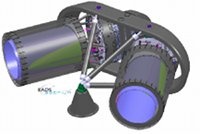Gravitational waves in the limelight at the International LISA Symposium
28 June 2010
Scientists from around the world are gathering at Stanford University, California, to discuss the latest developments in the pioneering Laser Interferometer Space Antenna (LISA) mission.The 8th International LISA Symposium, to be held 28 June – 2 July, is the latest in a biennial series of meetings which provides the scientific community with the opportunity to consider the current state of technical and scientific preparation for the mission and recent progress in the field of gravitational wave detection. The symposium is the main scientific gathering devoted to the detection and observation of low-frequency gravitational waves.
The programme will begin with overviews of both the LISA and LISA Pathfinder mission status as well as the various ground-based gravitational wave detectors located in Europe and the United States. It will also include reports on the latest analysis of data from the Gravity Probe B mission and the possible relevance to LISA.
However, the main focus of the symposium will be discussions of the scientific and technological challenges facing LISA and its precursor flight demonstration mission, LISA Pathfinder. Particular emphasis will be placed on the development of the incredibly sensitive instruments and the in-depth data analysis that will be required to detect the elusive gravitational ripples generated by distant cosmic catastrophes.
Most of the flight model units for the LISA Pathfinder mission have now been delivered and are already undergoing satellite integration and testing. However, the three LISA spacecraft will have more complex and different optical components than those carried by its forerunner, and delegates will report on the progress made during dedicated interferometry studies for LISA.
Presentations will also be made on the Mock LISA Data Challenge, a series of data simulation exercises designed to prepare the scientific community for the challenge of analysing the results from LISA. These exercises help to foster the development of LISA data analysis tools and capabilities, and to demonstrate the technical readiness of the gravitational wave community to take advantage of LISA's scientific legacy.
Background
LISA is a joint ESA-NASA mission to observe astrophysical and cosmological sources of low frequency gravitational waves. It is one of three candidate Large (L-class) missions for ESA's long-term Cosmic Vision science programme. Studies of LISA and the other L-class candidates (IXO and EJSM) will be completed this summer. A decision on the mission(s) to go forward will be announced in the middle of 2011. Launch is expected no earlier than 2020.
LISA is intended to detect gravitational waves emitted by massive black hole binaries that form after galactic mergers, by compact stellar remnants as they slowly spiral to destruction in supermassive black holes at the centres of galaxies, and by millions of compact binaries in our own Galaxy. It may also pick up the faint ripples generated shortly after the Big Bang, nearly 14 billion years ago. LISA consists of three identical spacecraft flying in a triangular constellation, with equal arms of 5 million kilometres each. As gravitational waves from distant sources reach LISA, they warp space-time, stretching and compressing the triangle. By precisely monitoring the separation between the spacecraft, it is possible to detect and measure the waves. By studying the shape and timing of the waves, scientists can learn about their nature and origins. Much of the technology will be flight-tested on the LISA Pathfinder technology demonstration mission, to be launched in 2012.





